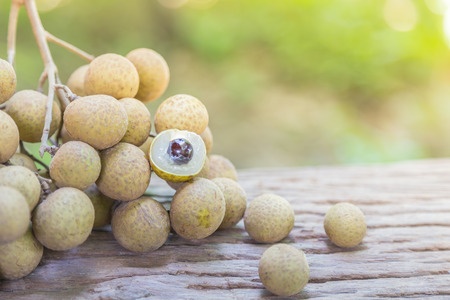
The Longan is a fruit which is related to the lychee and rambutan. It is colloquially known as the ‘little brother of the lychee’ in Thailand. All these three fruits belong to the same family of trees, the Sapindaceae. The species is knowns as Dimocarpus longan Lour. (syn. Euphoria longana Lamk.). There is a sub-species called mata kucing (D. longan ssp. malesianus Leenh.).
Appearance
The Longan is slightly smaller than a lychee but with a duller brown skin that is much smoother. There are taste and flavour similarities too. It grows as a cluster. The fruit is spherical or globose, with a ½ to 1 inch (3cm) diameter. The rind is thin and brittle when opened. The colour of this rind is between yellow and brown which develops a more red tint as it ripens.
The flesh is white like lychee and similarly translucent. The flavour is musky and less sweet with a light but indistinct floral or perfumed aroma. The seeds are small, round and jet-black with a circular white spot at their base which makes it look like an eye.
In commercial growing, the longan fruit is grown mainly as a dessert fruit for particular ethnic cuisine. It follows the lychee onto the market because it has a slightly later ripening period and helps extend the season for this type of dessert. It is popular throughout China, Thailand, Taiwan with a growing following in Western cuisine looking to explore novel flavours.
Longans are normally canned or preserved dry in their intact form or when the skin or rind has been removed.
Composition
The seeds are full of antioxidants mainly because of their high phenolic or polyphenolic content (Soong & Barlow, 2004).
What Are The Health Benefits Ascribed To Longan ?
The longan fruit has long been used in Chinese and other herbal medicines throughout south-east asia. The fruit has long been used by many to ease stomach cramps and aching, lack of sleep or insomnia, amnesia or memory loss and dropsy although there is very little if any supporting clinical evidence for these benefits.
The fruit in more specific circumstances is said to reduce anxiety and induce calmness. Other uses for it include improving the blood and reducing heart palpitations ‘caused by fright’. Again no real evidence is available to support its use.
The seeds are traditionally used to counter sweating. It was traditionally used in Vietnam for relieving snakebite. The eye of the seed which resembles that of a snake was believed to absorb snake venom if pressed against the wound.
The kernel is ground to a paste where it is applied to wounds as a styptic which means it can stem bleeding.
We will explore the health benefits at a later date
References
Soong, Y.Y., Barlow, P.J. (2004) Antioxidant activity and phenolic content of selected fruit seeds. Food Chem. 88(3) pp. 411–7
Leave a Reply